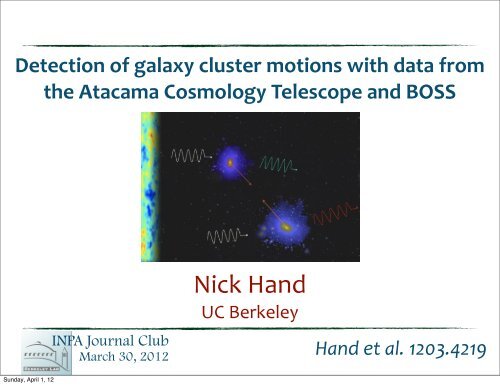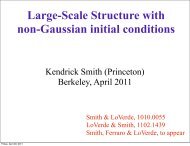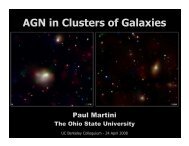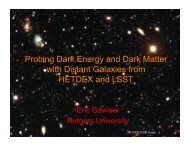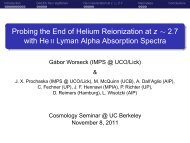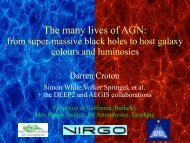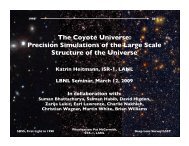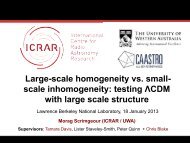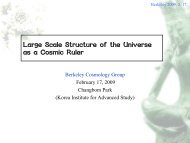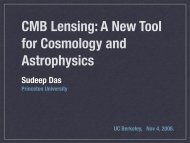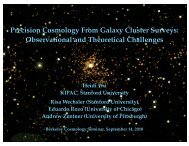Nick Hand - Berkeley Cosmology Group
Nick Hand - Berkeley Cosmology Group
Nick Hand - Berkeley Cosmology Group
You also want an ePaper? Increase the reach of your titles
YUMPU automatically turns print PDFs into web optimized ePapers that Google loves.
Detection of galaxy cluster motions with data from<br />
Sunday, April 1, 12<br />
the Atacama <strong>Cosmology</strong> Telescope and BOSS<br />
INPA Journal Club<br />
<strong>Nick</strong> <strong>Hand</strong><br />
UC <strong>Berkeley</strong><br />
<strong>Hand</strong> et al. 1203.4219<br />
March 30, 2012 <strong>Nick</strong> <strong>Hand</strong>, UC <strong>Berkeley</strong> 1
Sunday, April 1, 12<br />
Outline<br />
•SZ background information<br />
•order of magnitude estimates<br />
•breakdown of <strong>Hand</strong> et al. 1203.4219<br />
-‐ methodology<br />
-‐ results<br />
•applications / future work<br />
INPA Journal Club<br />
March 30, 2012 <strong>Nick</strong> <strong>Hand</strong>, UC <strong>Berkeley</strong> 2
Sunday, April 1, 12<br />
Some historical context ...<br />
Sunyaev & Zel’dovich (1972)<br />
How to explain the<br />
observed ‘hole’ in<br />
the Coma cluster?<br />
INPA Journal Club<br />
March 30, 2012 <strong>Nick</strong> <strong>Hand</strong>, UC <strong>Berkeley</strong> 3
Sunday, April 1, 12<br />
The thermal Sunyaev-‐Zel’dovich effect<br />
Menanteau et al. (2012)<br />
TtSZ<br />
TCMB<br />
= f(x)y =<br />
-‐ inverse Compton scattering between<br />
free electrons and CMB photons<br />
-‐ arcminute-‐scale decrement at 148 GHz<br />
-‐ measures the thermal content<br />
-‐ nearly independent of redshift<br />
✓ x(e x + 1)<br />
e x 1<br />
◆ Z<br />
4<br />
unique frequency<br />
dependence<br />
electron gas<br />
pressure<br />
INPA Journal Club<br />
March 30, 2012 <strong>Nick</strong> <strong>Hand</strong>, UC <strong>Berkeley</strong> 4<br />
T<br />
nekTe<br />
d`<br />
mec2
Sunday, April 1, 12<br />
The thermal Sunyaev-‐Zel’dovich effect<br />
Menanteau et al. (2012)<br />
TtSZ<br />
TCMB<br />
= f(x)y =<br />
-‐ inverse Compton scattering between<br />
free electrons and CMB photons<br />
-‐ arcminute-‐scale decrement at 148 GHz<br />
-‐ measures the thermal content<br />
-‐ nearly independent of redshift<br />
✓ x(e x + 1)<br />
e x 1<br />
◆ Z<br />
4<br />
unique frequency<br />
dependence<br />
electron gas<br />
pressure<br />
INPA Journal Club<br />
March 30, 2012 <strong>Nick</strong> <strong>Hand</strong>, UC <strong>Berkeley</strong> 4<br />
T<br />
nekTe<br />
d`<br />
mec2
Sunday, April 1, 12<br />
The kinematic Sunyaev-‐Zel’dovich effect<br />
TkSZ<br />
TCMB<br />
= ⌧<br />
-‐ Doppler-‐induced temperature distortion<br />
of CMB photons<br />
-‐ measures integrated momentum<br />
-‐ no frequency dependence for<br />
temperature distortion<br />
-‐ also nearly independent of redshift<br />
⇣ vpec<br />
c<br />
⌘<br />
=<br />
electron gas<br />
momentum<br />
INPA Journal Club<br />
March 30, 2012 <strong>Nick</strong> <strong>Hand</strong>, UC <strong>Berkeley</strong> 5<br />
Z<br />
T<br />
nevpec<br />
c<br />
d`
Sunday, April 1, 12<br />
The SZ shifts for a massive cluster<br />
assumes kTe = 5 keV, vpec = 300 km/s<br />
kSZ signal is<br />
smaller by an<br />
order of<br />
magnitude!<br />
INPA Journal Club<br />
March 30, 2012 <strong>Nick</strong> <strong>Hand</strong>, UC <strong>Berkeley</strong> 6
Measuring the kSZ effect with ACT<br />
• PI: Lyman Page, Princeton<br />
• 80 scientists on 5 continents<br />
• 6-‐meter telescope on Cerro<br />
Tocco (5200 m) in the<br />
Atacama Desert.<br />
• Observing the sky at 148, 218<br />
and 277 GHz<br />
Sunday, April 1, 12<br />
INPA Journal Club<br />
March 30, 2012 <strong>Nick</strong> <strong>Hand</strong>, UC <strong>Berkeley</strong> 7
Measuring the kSZ effect with ACT<br />
• PI: Lyman Page, Princeton<br />
• 80 scientists on 5 continents<br />
• 6-‐meter telescope on Cerro<br />
Tocco (5200 m) in the<br />
Atacama Desert.<br />
• Observing the sky at 148, 218<br />
and 277 GHz<br />
Sunday, April 1, 12<br />
How to achieve necessary S/N for a kSZ<br />
measurement?<br />
INPA Journal Club<br />
March 30, 2012 <strong>Nick</strong> <strong>Hand</strong>, UC <strong>Berkeley</strong> 7
Sunday, April 1, 12<br />
Cross-‐correlate ACT with BOSS!<br />
INPA Journal Club<br />
March 30, 2012 <strong>Nick</strong> <strong>Hand</strong>, UC <strong>Berkeley</strong> 8
BOSS in process of obtaining spectra for 1.5<br />
million luminous galaxies<br />
Two galaxy samples in upcoming DR9 release<br />
LOZ: 0.2 < z < 0.4, zmed ~ 0.3<br />
CMASS: 0.4 < z < 0.7, zmed ~ 0.57<br />
Preferentially sit in massive halos: ~10 13 -‐ 10 14 Msun<br />
Sunday, April 1, 12<br />
Mapping ‘Luminous Galaxies’ with BOSS<br />
INPA Journal Club<br />
March 30, 2012<br />
<strong>Nick</strong> <strong>Hand</strong>, UC <strong>Berkeley</strong><br />
9
BOSS in process of obtaining spectra for 1.5<br />
million luminous galaxies<br />
Two galaxy samples in upcoming DR9 release<br />
LOZ: 0.2 < z < 0.4, zmed ~ 0.3<br />
CMASS: 0.4 < z < 0.7, zmed ~ 0.57<br />
Preferentially sit in massive halos: ~10 13 -‐ 10 14 Msun<br />
Sunday, April 1, 12<br />
Mapping ‘Luminous Galaxies’ with BOSS<br />
Redshifts/sky locations<br />
for thousands of<br />
potential clusters<br />
INPA Journal Club<br />
March 30, 2012<br />
<strong>Nick</strong> <strong>Hand</strong>, UC <strong>Berkeley</strong><br />
9
BOSS in process of obtaining spectra for 1.5<br />
million luminous galaxies<br />
Two galaxy samples in upcoming DR9 release<br />
LOZ: 0.2 < z < 0.4, zmed ~ 0.3<br />
CMASS: 0.4 < z < 0.7, zmed ~ 0.57<br />
Preferentially sit in massive halos: ~10 13 -‐ 10 14 Msun<br />
Sunday, April 1, 12<br />
Mapping ‘Luminous Galaxies’ with BOSS<br />
Redshifts/sky locations<br />
for thousands of<br />
potential clusters<br />
INPA Journal Club<br />
March 30, 2012<br />
Two relevant questions:<br />
<strong>Nick</strong> <strong>Hand</strong>, UC <strong>Berkeley</strong><br />
9
Mapping ‘Luminous Galaxies’ with BOSS<br />
BOSS in process of obtaining spectra for 1.5<br />
million luminous galaxies<br />
Two galaxy samples in upcoming DR9 release<br />
LOZ: 0.2 < z < 0.4, zmed ~ 0.3<br />
CMASS: 0.4 < z < 0.7, zmed ~ 0.57<br />
Redshifts/sky locations<br />
for thousands of<br />
Preferentially sit in massive halos: ~10 13 -‐ 10 14 Msun<br />
potential clusters<br />
INPA Journal Club<br />
March 30, 2012<br />
Two relevant questions:<br />
1. What tSZ/kSZ amplitude should we expect in<br />
this halo mass range?<br />
Sunday, April 1, 12<br />
<strong>Nick</strong> <strong>Hand</strong>, UC <strong>Berkeley</strong><br />
9
Mapping ‘Luminous Galaxies’ with BOSS<br />
BOSS in process of obtaining spectra for 1.5<br />
million luminous galaxies<br />
Two galaxy samples in upcoming DR9 release<br />
LOZ: 0.2 < z < 0.4, zmed ~ 0.3<br />
CMASS: 0.4 < z < 0.7, zmed ~ 0.57<br />
Redshifts/sky locations<br />
for thousands of<br />
Preferentially sit in massive halos: ~10 13 -‐ 10 14 Msun<br />
potential clusters<br />
INPA Journal Club<br />
March 30, 2012<br />
Two relevant questions:<br />
1. What tSZ/kSZ amplitude should we expect in<br />
this halo mass range?<br />
2. How many galaxies to achieve a given S/N?<br />
Sunday, April 1, 12<br />
<strong>Nick</strong> <strong>Hand</strong>, UC <strong>Berkeley</strong><br />
9
SZ vs halo mass: order of magnitude scaling<br />
Thermal SZ Kinematic SZ<br />
TtSZ / ⌧(M)Te(M)<br />
Te / M 2/3<br />
⌧ / M<br />
TtSZ / M 5/3<br />
If |δTtSZ| = 10 |δTkSZ| at M = 10 15 Msun:<br />
Sunday, April 1, 12<br />
TkSZ / ⌧(M)<br />
⌧ / M<br />
TkSZ / M<br />
SZ signals equal at Meq ≃ 3 x 10 13 Msun<br />
INPA Journal Club<br />
March 30, 2012 <strong>Nick</strong> <strong>Hand</strong>, UC <strong>Berkeley</strong> 10
δTtSZ at 148 GHz<br />
δTkSZ uses<br />
vpec = 300 km/s<br />
|δTtSZ| ~ |δTkSZ|<br />
~ 1 μK<br />
in relevant halo<br />
mass range for BOSS<br />
Sunday, April 1, 12<br />
a little more quantitatively ...<br />
Meq ≃ 2.1 x 10 13 Msun<br />
INPA Journal Club<br />
March 30, 2012 <strong>Nick</strong> <strong>Hand</strong>, UC <strong>Berkeley</strong> 11
How many galaxies for a given kSZ S/N?<br />
• Consider Poisson noise in Nobj: Npoisson / (Nobj) 1/2<br />
• Estimate the ACT pixel noise:<br />
Sunday, April 1, 12<br />
order of magnitude estimate:<br />
Nobj ⇠<br />
apple (S/N) ACT<br />
TkSZ(M)<br />
INPA Journal Club<br />
March 30, 2012 <strong>Nick</strong> <strong>Hand</strong>, UC <strong>Berkeley</strong> 12<br />
2<br />
ACT ' 20 µK/pixel
Sunday, April 1, 12<br />
How many galaxies for a given kSZ S/N?<br />
5,000 -‐ 10,000<br />
galaxies needed for<br />
~4σ detection at<br />
average mass<br />
~4 x 10 13 Msun<br />
INPA Journal Club<br />
March 30, 2012 <strong>Nick</strong> <strong>Hand</strong>, UC <strong>Berkeley</strong> 13
Sunday, April 1, 12<br />
How many galaxies for a given kSZ S/N?<br />
5,000 -‐ 10,000<br />
galaxies needed for<br />
~4σ detection at<br />
average mass<br />
~4 x 10 13 Msun<br />
possible with<br />
ACT x BOSS<br />
correlation<br />
INPA Journal Club<br />
March 30, 2012 <strong>Nick</strong> <strong>Hand</strong>, UC <strong>Berkeley</strong> 13
ACT Data<br />
•148 GHz sky map taken from<br />
2008-2010<br />
• strip 3° wide and 110° long<br />
centered on celestial equator<br />
• 1.4′ angular resolution<br />
• noise per pixel: 15 - 25 μK<br />
Sunday, April 1, 12<br />
BOSS Data<br />
• galaxies drawn from both<br />
CMASS and LOZ DR9 samples<br />
• right ascension slightly smaller<br />
than ACT footprint:<br />
−43° < α < 45°<br />
-‐ 27,291 BOSS galaxies in overlap region<br />
-‐ about 100 galaxies per sq. degree on sky<br />
-‐ exclude any galaxies falling within 1′ of 1.4 GHz<br />
FIRST radio source<br />
INPA Journal Club<br />
March 30, 2012 <strong>Nick</strong> <strong>Hand</strong>, UC <strong>Berkeley</strong> 14
Sunday, April 1, 12<br />
Sample redshift distribution<br />
range: 0.05 < z < 0.8<br />
mean redshift: z = 0.51<br />
INPA Journal Club<br />
March 30, 2012 <strong>Nick</strong> <strong>Hand</strong>, UC <strong>Berkeley</strong> 15
Verifying the galaxy sample traces massive halos ...<br />
First, stack filtered ACT data at galaxy locations to<br />
compute tSZ signal<br />
Sunday, April 1, 12<br />
-‐ Filtering process identical to <strong>Hand</strong> et al., ApJ (2011)<br />
-‐ Before applying the filter:<br />
-‐ Mask point sources with S/N > 5 in ACT data<br />
-‐ weight map by q<br />
Nobs(x)/Nobs,max<br />
INPA Journal Club<br />
March 30, 2012 <strong>Nick</strong> <strong>Hand</strong>, UC <strong>Berkeley</strong> 16
Verifying the galaxy sample traces massive halos ...<br />
-‐ match filter ACT data in Fourier space:<br />
Tfilt(k) =<br />
signal profile B(θ) chosen<br />
to be equal to ACT 148 GHz<br />
beam function (θ = 1.4′)<br />
Sunday, April 1, 12<br />
˜B ? (k) | ˜ T other(k)| 2 ˜ T (k)<br />
R ˜B ? (k 0 ) | ˜ T other(k 0 )| 2 ˜ B(k 0 )dk 0<br />
INPA Journal Club<br />
March 30, 2012 <strong>Nick</strong> <strong>Hand</strong>, UC <strong>Berkeley</strong> 17
Sunday, April 1, 12<br />
tSZ Stacking Methods<br />
-‐ Verify that galaxy luminosity correlates with halo mass<br />
-‐ Bin galaxy sample by r-‐band luminosity, as in <strong>Hand</strong> et<br />
al., ApJ (2011)<br />
-‐ luminosities computed from CMODEL magnitudes<br />
-‐ Perform weighted sum of filtered ACT 10′ x 10′ submaps<br />
centered on each galaxy<br />
INPA Journal Club<br />
March 30, 2012 <strong>Nick</strong> <strong>Hand</strong>, UC <strong>Berkeley</strong> 18
148 GHz<br />
Sunday, April 1, 12<br />
results<br />
tSZ Stacking Results<br />
218 GHz results<br />
‘dust-‐subtracted’<br />
148 GHz results<br />
TtSZ ⌘ T148 0.325 T218<br />
see Hall et al., 2010<br />
(SPT power spectra)<br />
INPA Journal Club<br />
March 30, 2012 <strong>Nick</strong> <strong>Hand</strong>, UC <strong>Berkeley</strong> 19
Sunday, April 1, 12<br />
now on to measuring the kSZ signal ...<br />
INPA Journal Club<br />
March 30, 2012 <strong>Nick</strong> <strong>Hand</strong>, UC <strong>Berkeley</strong> 20
The pairwise momentum statistic<br />
now have thousands of cluster line-‐of-‐sight momenta, from<br />
kSZ temperature shift in ACT data<br />
-‐ compute the mean pairwise momentum:<br />
ppair(r) ⌘h(p i<br />
p j) · ˆriji<br />
-‐ ppair < 0 when two objects moving towards each other<br />
-‐ measures the mean tendency of objects to approach<br />
each other due to gravitational attraction<br />
Sunday, April 1, 12<br />
INPA Journal Club<br />
March 30, 2012 <strong>Nick</strong> <strong>Hand</strong>, UC <strong>Berkeley</strong> 21
The pairwise momentum statistic<br />
-‐ we can estimate ppair using only line-‐of-‐sight momenta:<br />
˜ppair(r) =<br />
P<br />
i
Pairwise Momentum from the kSZ Shift<br />
-‐ relate line-‐of-‐sight momenta to measured kSZ<br />
temperature shift in ACT data<br />
TkSZ,i ⌘ NkSZ p i · ˆri<br />
-‐ NkSZ depends on ACT pixel scale, beam size, cluster profile<br />
estimate NkSZ from Seghal et al.<br />
(2010) microwave sky simulations<br />
Sunday, April 1, 12<br />
vpec = 200 km/s, M200 = 10 13 Msun:<br />
|TkSZ| ≃ 0.9 μK<br />
vpec = 200 km/s, M200 = 10 14 Msun:<br />
|TkSZ| ≃ 2.2 μK<br />
INPA Journal Club<br />
March 30, 2012 <strong>Nick</strong> <strong>Hand</strong>, UC <strong>Berkeley</strong> 23
Possible Contamination Sources<br />
-‐ advantageous systematic error properties<br />
-‐ linear and differential<br />
-‐ tSZ signal from individuals clusters will subtract out<br />
-‐ redshift-‐dependent signals can lead to erroneous signal<br />
Sunday, April 1, 12<br />
-‐ subtract out mean temperature at given redshift<br />
˜pkSZ(r) =<br />
P<br />
i
Sunday, April 1, 12<br />
Mean Pairwise Momentum Detection<br />
-‐ bin errors computed by bootstrap resampling<br />
-‐ 3.8σ away from zero, including correlations<br />
between bins<br />
compute pkSZ for<br />
7500 most<br />
luminous galaxies<br />
using ACT 148<br />
data, filtered at<br />
scale θ = 4.2′<br />
INPA Journal Club<br />
March 30, 2012 <strong>Nick</strong> <strong>Hand</strong>, UC <strong>Berkeley</strong> 25
compute same<br />
summation for pkSZ but:<br />
Sunday, April 1, 12<br />
1. using random sky<br />
locations (blue)<br />
2. changing the sign in<br />
the 2nd term of pkSZ<br />
from negative to<br />
positive (red)<br />
Null Tests<br />
both tests consistent with zero<br />
INPA Journal Club<br />
March 30, 2012 <strong>Nick</strong> <strong>Hand</strong>, UC <strong>Berkeley</strong> 26
Sunday, April 1, 12<br />
Fitting for the average halo mass<br />
-‐ we can relate the kSZ momentum estimator to<br />
the mean pairwise velocity:<br />
pkSZ(r) =NkSZ hMhaloi fb vpair(r) baryon<br />
fraction<br />
-‐ assume fb equal to cosmological value<br />
-‐ vary in Seghal et al. simulations to get best fit to<br />
data results:<br />
hM200i '4.0 ⇥ 10 13 M<br />
M200,cut ' 2.5 ⇥ 10 13 M<br />
roughly consistent with BOSS clustering masses<br />
INPA Journal Club<br />
March 30, 2012 <strong>Nick</strong> <strong>Hand</strong>, UC <strong>Berkeley</strong> 27
Missing Baryon Problem<br />
-‐ baryon fraction known at high redshift from Big Bang<br />
nucleosynthesis and at z ≃ 3 from studies of Lyα lines<br />
-‐ census of baryons at low redshift<br />
Sunday, April 1, 12<br />
➡ only 1/10 of amount at high redshift<br />
‘missing’ baryons believed to be gas filaments connecting<br />
virialized groups and clusters (~0.5 -‐ 10 x 10 6 K)<br />
INPA Journal Club<br />
March 30, 2012 <strong>Nick</strong> <strong>Hand</strong>, UC <strong>Berkeley</strong> 28
Using pkSZ to measure the baryon fraction?<br />
-‐ kSZ effect is proportional to electron gas number density<br />
-‐ no dependence on temperature (unlike tSZ effect)<br />
ACT maps filtered at scale 4.2′, corresponds to ~1 Mpc at z= 0.5<br />
pkSZ is measuring fb on Mpc scales in groups/clusters<br />
Need to carefully compute and for galaxy sample:<br />
Sunday, April 1, 12<br />
pkSZ(r) =NkSZ hMhaloi fb vpair(r)<br />
compute vpair(r) using , assuming fiducial ΛCDM model<br />
measure fb from the amplitude of pkSZ<br />
INPA Journal Club<br />
March 30, 2012 <strong>Nick</strong> <strong>Hand</strong>, UC <strong>Berkeley</strong> 29
Sunday, April 1, 12<br />
Summary<br />
-‐ kSZ effect sensitive to cluster motions on cosmological<br />
scales unique probe of large scale structure<br />
-‐ combination of ACT and BOSS data sets has detected<br />
galaxy cluster motions using the kSZ effect<br />
-‐ kSZ effect probes electron distribution around groups /<br />
clusters finding the missing baryons?<br />
-‐ future improved measurements:<br />
ACTPol: increased sensitivity, larger sky coverage<br />
BigBOSS: deeper with increased sky coverage<br />
-‐ kSZ effect opening new window into the large scale<br />
structure<br />
INPA Journal Club<br />
March 30, 2012 <strong>Nick</strong> <strong>Hand</strong>, UC <strong>Berkeley</strong> 30
Sunday, April 1, 12<br />
Thank You<br />
INPA Journal Club<br />
March 30, 2012 <strong>Nick</strong> <strong>Hand</strong>, UC <strong>Berkeley</strong> 31


